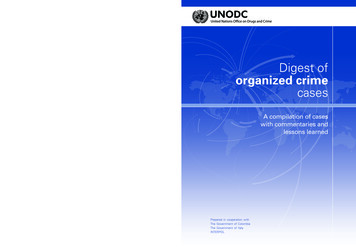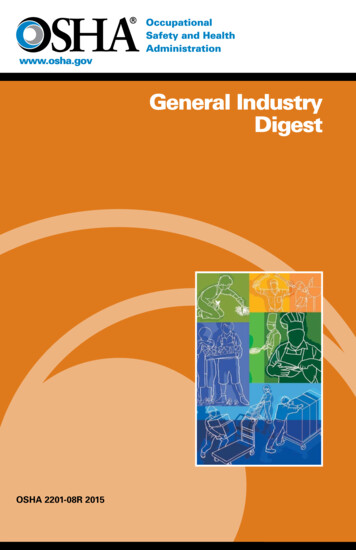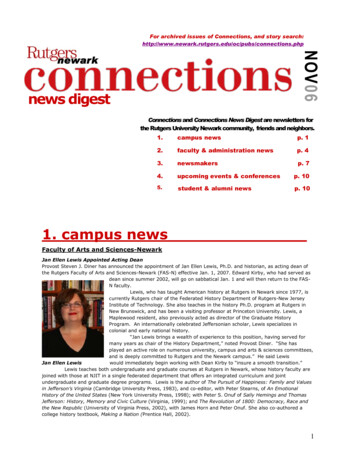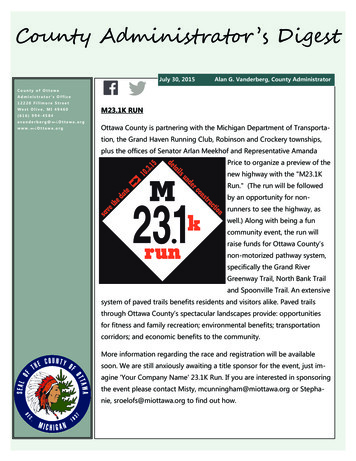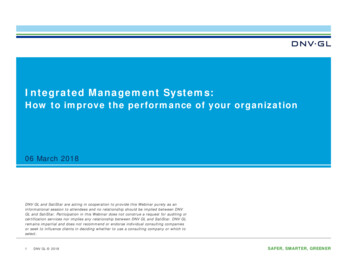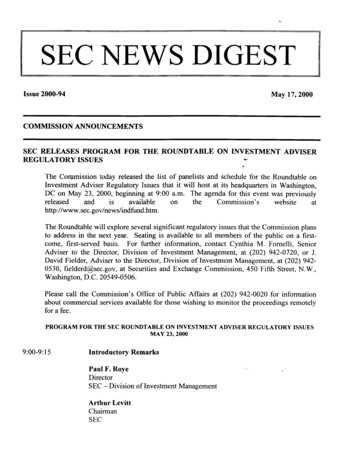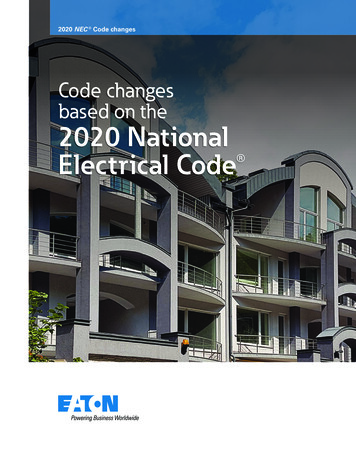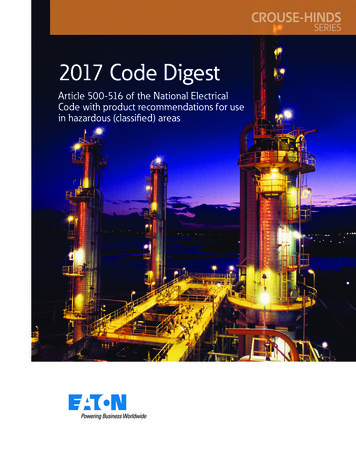
Transcription
2017 Code DigestArticle 500-516 of the National ElectricalCode with product recommendations for usein hazardous (classified) areas
2017 Code Digest22017 Code DigestEATON’S CROUSE-HINDS
2017 Code DigestArticle 500 Hazardous(Classified) LocationsContentsPageIntroduction. 1l.Classification of HazardousAtmospheresII. Prevention of External Ignition andExplosionIll. Equipment for Hazardous AreasIV. Wiring Methods and MaterialsV. Maintenance PrinciplesVI. Selected Articles from the NationalElectrical Code 2017AppendicesHazardous Area ReferenceEATON’S CROUSE-HINDS BUSINESSA.The National Electrical Code . 2B.Class I Atmospheric Hazards. 2C.Class II Atmospheric Hazards. 2D.Class III Atmospheric Hazards. 2E.Evaluation of Hazardous Areas. 2A.Enclosures. 3B.Purging/Pressurization Systems. 3C.Intrinsically Safe Equipment. 3A.Switchgear and Industrial Controls. 4B.Luminaires (Lighting Fixtures). 4C.Motors and Generators. 5D.Plugs and Receptacles. 6E.Portable Devices. 6A.Conduit. 7B.Seals for Conduit System. 7C.Mineral-Insulated Cable. 8D.Metal-Clad Cable. 8E.Tray Cable. 8F.Other Permitted Cables. 8G.Cable Sealing. 8H.Nonmetallic Conduit. 8A.Electrical Circuits. 9B.Assembly or Disassembly of Enclosures. 9C.Cover Attachment Screws. 9D.Cleaning and Lubrication. 9E.Shaft and Bearing Surfaces. 9F.Corrosive Locations. 9G.Portable Equipment. 9H.Overall Safety. 9I.Plug-in Replacement Units. 9J.Maintenance. 9500 Hazardous (Classified) Locations. 10501 Class I Locations. 17502 Class II Locations. 35503 Class III Locations. 44504 Intrinsically Safe Systems. 48505 Class I, Zone 0, 1 and 2 Locations. 51506 Zone 20, 21, and 22 Locations for Combustible Dusts, Ignitible Fibers/Flyings. 67510 Hazardous (Classified) Locations – Specific. 74511 Commercial Garages, Repair and Storage. 74513 Aircraft Hangars. 78514 Motor Fuel Dispensing Facilities. 80515 Bulk Storage Plants. 86516 Spray Application, Dipping and Coating Processes. 90I & II Hazardous Substances Used in Business and Industry.100-105ITable I – Gases and Vapors – Hazardous Substances Used in Business and Industry. 102IITable II – Dusts – Hazardous Substances Used in Business and Industry. 105IIISelection of Seals and Drains. 107IVInstallation Diagram for Sealing. 111VDiagram for Class I, Zone 1 Power and Lighting Installation. 112VIDiagram for Class I, Division 1 Lighting Installation. 113VII Diagram for Class I, Division 1 Power Installation. 114VIII Diagram for Class I, Division 2 Power and Lighting Installation. 115IXDiagram for Class II Lighting Installation. 116XDiagram for Class II Power Installation. 117XI“Quick Selector” Electrical Equipment for Hazardous Locations. 118Global reference guide for potentially explosive atmospheres and hazardous locations. 1192017 Code DigestC3
2017 Code Digest42017 Code DigestEATON’S CROUSE-HINDS
2017 Code DigestIntroductionForewordB. Combustion Principles.Eaton’s Crouse-Hinds has revised its Code Digest for 2017 to meetthe needs of design personnel for a ready reference to equipmentand installation ideas in hazardous locations. Selected Articlesfrom the National Electrical Code have been explained withdiagrams and photographs of electrical hardware taken from ourEaton’s Crouse-Hinds Division Product Catalog. Exhaustivelaboratory testing and extensive research, development and fieldexperience have proven that these items meet or exceed therequirements set forth by the National Electrical Code andUnderwriters Laboratories Inc. Three basic conditions must be satisfied for a fire or explosion to occur:This latest revision to the series of Eaton’s Crouse-Hinds Divisionservice-oriented bulletins reflects the most recent changes in theNational Electrical Code in Articles 500 through 516. Reproductionof these Articles has been made with the permission of the NationalFire Protection Association.Diagrams of recommended power and lighting installations havebeen included in Appendices V, VI, VII, VIII, IX and X to assistengineers involved in the design of these systems for hazardouslocations. A “Quick-Selector” Guide for electrical equipment usedfor Class I, Class II and Class III installations is included inAppendix XI. Tables included are those of most frequentapplicability and usage. Photographs of actual application ofEaton’s Crouse-Hinds series products for a variety of environmentshave been added for clarity and specific reference.We sincerely hope that this Digest will be of value to you. Feel freeto call on your Eaton’s Crouse-Hinds Division representative forpersonal assistance in your installation planning at any time.A. The National Electrical Code and UnderwritersLaboratories Inc.The NEC is a product of the National Fire Protection Association. It isconsidered the definitive classification tool and contains explanatorydata about flammable gases and combustible dusts as it may apply tostorage areas, garages, gasoline stations and other facilities whereflammable or combustible materials are found. Specific installationpractices have been set up for heavier-than-air vapors. In the case ofhydrogen or other gas which has a low vapor density and is usedindoors, the most hazardous concentrations are likely to be in the upperportion of the room.Many states, municipalities and public service companies use the NECas a requirement for their inspectors.Underwriters Laboratories Inc. (UL), Canadian Standards Association(CSA), Factory Mutual (FM), and Intertek (ETL), are independentorganizations that test for public safety. Their function is to determinewhether or not devices and equipment submitted to them are safe andcan be used in the NEC category for which they were designed. To dothis, these agencies maintain extensive laboratory and testing facilities.It is not the function of these agencies to perform actual enforcementof the National Electric Code. However, as previously indicated,inspection authorities use the certifications and listings from theseagencies in carrying out their inspections of hazardous areas.1. A flammable liquid, vapor or combustible dust must be present insufficient quantity.2. The flammable liquid, vapor or combustible dust must be mixed withair or oxygen in the proportions required to produce an explosivemixture.3. A source of energy must be applied to the explosive mixture.In applying these principles, the quantity of the flammable liquid orvapor that may be liberated and its physical characteristics must berecognized.Vapors from flammable liquids also have a natural tendency to disperseinto the atmosphere, and rapidly become diluted to concentrationsbelow the lower flammable limit, particularly when there is natural ormechanical ventilation.The possibility that the gas concentration may be above the upperflammable limit does not afford any degree of safety, as theconcentration must first pass through the flammable range to reach theupper flammable limit.C. Sources of Ignition.A source of energy is all that is needed to touch off an explosion whenflammable gases or combustible dusts are mixed in the properproportion with air.One prime source of energy is electricity. Equipment such as switches,circuit breakers, motor starters, pushbutton stations, or plugs andreceptacles, can produce arcs or sparks in normal operation whencontacts are opened and closed. This could easily cause ignition.Other hazards are devices that produce heat, such as luminaires andmotors. Here surface temperatures may exceed the safe limits of manyflammable atmospheres.Finally, many parts of the electrical system can become potentialsources of ignition in the event of insulation failure. This group wouldinclude wiring (particularly splices in the wiring), transformers,impedance coils, solenoids, and other low-temperature devices withoutmake-or-break contacts.Non-electrical hazards such as sparking metal can also easily causeignition. A hammer, file or other tool that is dropped on masonry or ona ferrous surface is thus a hazard unless the tool is made of non-sparkingmaterial. For this reason, portable electrical equipment is usually madefrom aluminum or other material that will not produce sparks if theequipment is dropped.Electrical safety, therefore, is of crucial importance. The electricalinstallation must prevent accidental ignition of flammable liquids,vapors and dusts released to the atmosphere. In addition, since much ofthis equipment is used outdoors or in corrosive atmospheres, thematerial and finish must be such that maintenance costs and shutdownsare minimized.National Electrical Code
For further information on classification of areas see NFPA 497 Recommended Practice for the Classification of Flammable Liquids, Gases or Vapors and of Hazardous (Classified) Locations for Electrical Installations in Chemical Process Areas and NFPA 499, Recommended Practice for the Classification of Combustible Dusts and of Hazardous (Classified) Locations for Electrical Installations
